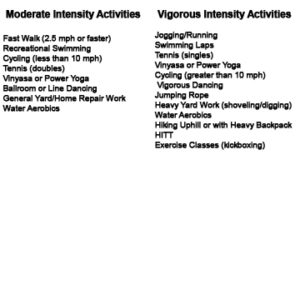Heart Healthy Strategies for Adults
Not only is this the month of Valentine’s Day it also happens to be National Heart Month. Let us use this month as a way to take an honest look at how well we take care of the most important organ, the heart. Here are a few questions you should be asking yourself to ensure you are doing the most for your health and well being.
HOW ACTIVE ARE YOU ON A WEEKLY BASIS?
If you don’t know the answer to this one or you aren’t sure how much you should be doing here are some scientific recommendations on how active adults should be during the week.
#1 Everyone needs to move more and sit less!
Some say that sitting is the new smoking. It is honestly all too true. People who are sedentary or who sit a lot during their day are at greater risk for developing Cardiovascular Disease, Type 2 Diabetes, lung cancer, and other forms of cancer. However, people who are physically active are far less likely to develop this increased risk of disease. If you participate in moderate intensity physical activity 60-75 minutes 3 or more days out of the week it decreases your disease risk.
#2 Any physical activity is better than none! By sitting less throughout the day and engaging in regular physical activity and participating in any amount of moderate to vigorous activity you are going to gain health benefits. For substantial health benefits, the recommended amount of physical activity per week equates to 150-300 minutes of moderate activity or 75-150 minutes of vigorous activity.
 #3 How to know how hard you are working- The Talk Test
#3 How to know how hard you are working- The Talk Test
A way to know how hard you are working at a specific activity that isn’t on the list above is to use the talk test. This test is used to know how high your heart rate is while working at a given intensity. You are most likely doing aerobic work if you can hold a conversation with ease or talk in full sentences. This is low to moderate intensity work and it can be performed for long periods of time. If you can only get a few words out at a time you are most likely working at your lactate threshold. This is moderate to vigorous intensity work and can be sustained for a good amount of time, but not as long as aerobic exercise. Finally, if you can barely speak then you are most likely working sub-maximally or doing anaerobic work. This intensity is vigorous to maximal and cannot be sustained for very long. Using these categories to gauge how high your heart rate is will help you determine what intensity you are working at.
#4 Muscular strength is just as important as aerobic exercise.
Aerobic exercise should be spread throughout the week as should strength training exercises. Muscle strengthening exercises should encompass all major muscle groups to really get a good full body workout. These workouts should be done at least twice a week if not three times per week. Combining both aerobic and strength training is the best recipe for limiting your risk of developing Cardiovascular disease and various cancers.
WHAT DOES YOUR NUTRITIONAL INTAKE LOOK LIKE?
As one ages there will be certain physiological changes that come with the territory. Some of these changes are inevitable, but there are some strategies to use to help delay them.
#1 Nutritional strategies will be different as you get older.
Adults might see a steep decline in muscular mass and strength after the age of 50. Right now the current nutritional recommendations for this age group may not be sufficient enough to keep up with this decline in muscular mass. It is suggested that one may need to increase their protein intake to 1 g – 1.2 g of protein per kg of body weight in order to retain and or increase muscle mass.
#2 Include nutrient rich or nutrient dense foods.
Eating healthy is always important, but what does that mean exactly? Eating a balanced diet means you are including nutrient rich foods into your diet. These foods include vibrant or brightly colored fruits and vegetables, whole grain or fiber rich grains, low fat and fat-free dairy products, beans and nuts, lean meats, poultry, fish, and eggs.
#3 Hydration is just as important as eating a balanced diet.
As one ages there will be a decline in the amount of body water you have. Staying hydrated will help with bodily functions and to keep the skin as elastic as possible. Staying hydrated is extremely important in older adults because they will experience a decreased thirst sensation with age, decreased ability to concentrate urine, and decrease in sweat production per sweat gland. There are also some medications or dietary supplements that alter body water. The typical 64 ounces per day is good to go off of, but if you have trouble getting in those 8 glasses of water a day try adding in more foods that are high in water content. Some examples of high water content foods are cucumbers, apples, grapes, tomatoes, bell peppers, and of course watermelon!
If you would like some more information about how to keep up your health and well-being during National Heart Month give us a call to schedule your FREE consultation at 310-582-8212 or email me directly at chelsea@phase-iv.net.








